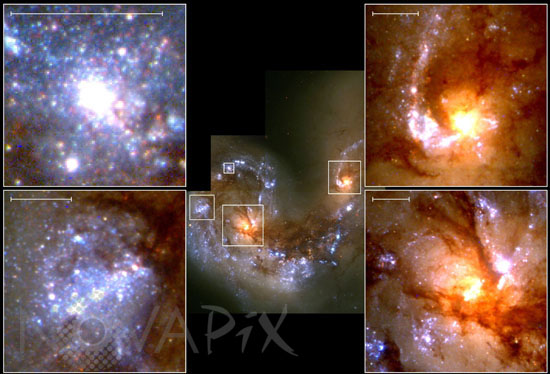Photo Agency - Astronomy - Space - Nature

The Antennae galaxy in Corvus
author: Nasa/Stsci/Novapix
reference: a-gax40-38002
Image Size 300 DPI: 23 * 15 cm
These four close-up views are taken from a head-on collision between two spiral galaxies, called the Antennae galaxies, seen at image center. The scale bar at the top of each image is 1,500 light-years across. Left: the collision triggers the birth of new stars in brilliant blue star clusters, the brightest of which contains roughly a million stars. The star clusters are blue because they are very young, the youngest being only a few million years old, a mere blink of the eye on the astronomical time scale.
Right:Â these close-up views of the cores of each galaxy show entrapped dust and gas funneled into the center. The nucleus of NGC 4038 (lower right) is obscured by dust which dims and reddens starlight by scattering the shorter, bluer wavelengths. This is also the reason the young star clusters in the dusty regions appear red instead of blue. This natural-color image is a composite of four separately filtered images taken with the Wide Field Planetary Camera 2 on January 20, 1996.
Right:Â these close-up views of the cores of each galaxy show entrapped dust and gas funneled into the center. The nucleus of NGC 4038 (lower right) is obscured by dust which dims and reddens starlight by scattering the shorter, bluer wavelengths. This is also the reason the young star clusters in the dusty regions appear red instead of blue. This natural-color image is a composite of four separately filtered images taken with the Wide Field Planetary Camera 2 on January 20, 1996.
Contact : Stéphane Aubin +33-(0)9-51-26-53-76
© Novapix - All rights reserved


